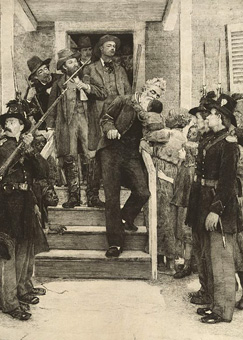resisting slavery
John Brown
By Arlene Rodríguez, Ph.D.Although the company failed, the four years Brown spent in Springfield were crucial to the abolitionist movement. His relationship with the African American community, his plans for the "Subterranean Pass Way," his introduction to Frederick Douglass, and the formation of the League of Gileadites make Brown's life in Springfield an important part of the abolitionist movement. As a result of this history, Springfield is one of the few locations in the country where Brown is honored as a hero and not vilified.
By the time he arrived, Brown believed the only way to end slavery was through violence. He expressed his own frustration with those in the African American community who did not share his view in an essay entitled "Sambo's Mistakes." Appearing in The Ram's Horn , a New York abolitionist newspaper published by freed blacks, the essay is written in the voice of a free black man who explains how the mindset of some African Americans only perpetuates their enslavement. Among the "mistakes" are the reading of "silly novels & other miserable trash" instead of "sacred & profane history" which would reveal "the true character of God & man"; courting favor with whites by "tamely submitting to every species of indignity contempt & wrong"; and practicing religious intolerance while proclaiming themselves to be abolitionists.
While in Springfield, Brown socialized extensively with the African American community, developing a strong friendship with Thomas Thomas, a former slave and porter at Perkins & Brown. He even shared with Thomas his plans for invading the South to end slavery, a prototype of Brown's later raid on Harper's Ferry. Brown also shared with Thomas his map for the Subterranean Pass Way, an expanded version of the Underground Railroad whereby a greater number of slaves would be sent North through the Appalachian Mountains.
In November 1847, Brown met slavery's most renowned critic, Frederick Douglass, who interrupted a speaking tour to meet him in Springfield. The two men shared dinner and spoke well into the night. Brown explained his plans for the southern invasion and the Subterranean Pass Way. On the fiftieth anniversary of the raid on Harper's Ferry, Douglass said that Brown "began the war that ended American slavery and made this a free Republic."
As a direct response to the Fugitive Slave Act of 1850, Brown formed the League of Gileadites, a reference to Mount Gilead, where Gideon was lead by God to save the Israelites. At first comprised of members of Springfield's African American community, the Gileadites came to include forty-four former slaves Brown assisted North through the Underground Railroad. For some historians, the League was a model for later racially integrated organizations such as the National Association for the Advancement of Colored People.
Brown's original mission in Springfield — to create a fair market for wool producers — failed and he found himself in debt again. After visiting the newly established integrated community of North Elba in Upstate New York, Brown decided to seek a new life there. After settling his Springfield accounts as best he could, Brown and his family relocated in 1851. It is clear, however, that Brown's life in Springfield was part of the greater mission to end slavery.
